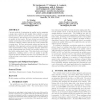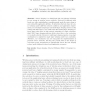346 search results - page 49 / 70 » Redundant Coverage in Wireless Sensor Networks |
TMC
2010
13 years 6 months ago
2010
—Recent years have witnessed the deployments of wireless sensor networks in a class of mission-critical applications such as object detection and tracking. These applications oft...
250
click to vote
Presentation
In this paper, we propose a decentralized method for maximizing lifetime of data collection wireless sensor networks (WSNs) by making minimal number of nodes operate and putting ot...
IOR
2008
13 years 8 months ago
2008
Wireless sensor networks pose numerous fundamental coordination problems. For instance, in a number of application domains including homeland security, environmental monitoring an...
SAC
2010
ACM
14 years 2 months ago
2010
ACM
Current methods of estimating air quality involve assigning a single value called the Air Quality Index (AQI) to a large land area for a 24-hour period based on a very few, sparse...
EWSN
2009
Springer
14 years 8 months ago
2009
Springer
Sensor sleeping is a widely-used and cost-effective technique to save energy in wireless sensor networks. Protocols at different stack levels can, either individually or simultaneo...


